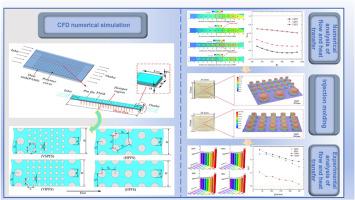Polymer-based pin-fin microchannel heat exchangers: A comparative study of material and structural effects on performance
IF 4.9
2区 工程技术
Q1 ENGINEERING, MECHANICAL
International Journal of Thermal Sciences
Pub Date : 2024-11-15
DOI:10.1016/j.ijthermalsci.2024.109546
引用次数: 0
Abstract
In this comprehensive study, the applicability and heat transfer dynamics of polymer pin-fin microchannel heat exchangers were investigated through a combination of experimental and numerical approaches. The findings revealed that enhancements in material thermal conductivity do not exhibit a linear correlation with improvements in heat transfer performance. Beyond a certain threshold, the impact of thermal conductivity on temperature stability diminishes significantly. Notably, polymer-based micro heat exchangers demonstrated remarkable temperature uniformity in comparison to other materials. To address the issue of localized thermal peaks in electronic chipsets, a heat exchanger featuring variable pin-fin sizes was designed. This design resulted in a significant reduction in the temperature of the heat source when compared to a constant-size pin-fin configuration. Specifically, variable-size pin-fin structures (the staggered-arrangement variable-size micro-needle-fin heat exchanger (VSPFS) and the inline-arrangement variable-size micro-needle-fin heat exchanger (VIPFS)) achieved temperature reductions in the range of 1.41–3.60K and 6.07–8.48K, respectively, when compared to their isometric counterparts (the staggered-arrangement constant-size micro-needle-fin heat exchanger (ISPFS) and the inline array of constant-size pin-fin microchannel heat exchanger (IIPFS)). Furthermore, these structures significantly decreased the average temperature difference across the heat source, effectively mitigating thermal hotspots by up to 3.23K and 5.73K, respectively. Among the tested configurations, VSPFS exhibited the highest Performance Evaluation Criterion (PEC) value and the smallest increase in entropy generation, highlighting its superior overall thermal management capability. Additionally, as the Reynolds number increased, convective heat transfer entropy generation decreased while fluid friction entropy generation increased, indicating that energy losses due to fluid friction gradually outweighed the benefits of enhanced heat transfer at higher Reynolds numbers.

基于聚合物的针翅微通道热交换器:材料和结构对性能影响的比较研究
在这项综合研究中,通过实验和数值方法的结合,对聚合物针状鳍片微通道热交换器的适用性和传热动力学进行了研究。研究结果表明,材料热导率的提高与传热性能的改善并不呈线性关系。超过一定临界值后,热导率对温度稳定性的影响会明显减弱。值得注意的是,与其他材料相比,聚合物基微型热交换器表现出显著的温度均匀性。为了解决电子芯片组中局部热峰值的问题,我们设计了一种具有可变针脚尺寸的热交换器。与恒定尺寸的针脚鳍片配置相比,这种设计大大降低了热源的温度。具体来说,可变尺寸针脚鳍片结构(交错排列可变尺寸微型针脚鳍片热交换器 (VSPFS) 和内嵌排列可变尺寸微型针脚鳍片热交换器 (VIPFS))的温度降低范围分别为 1.41-3.60K 和 6.60K。41-3.60K 和 6.07-8.48K 之间。此外,这些结构大大降低了整个热源的平均温差,分别有效缓解了高达 3.23K 和 5.73K 的热热点。在测试的配置中,VSPFS 的性能评估标准(PEC)值最高,产生的熵增加最小,凸显了其卓越的整体热管理能力。此外,随着雷诺数的增加,对流传热产生的熵减少了,而流体摩擦产生的熵却增加了,这表明在雷诺数较高时,流体摩擦造成的能量损失逐渐超过了增强传热所带来的好处。
本文章由计算机程序翻译,如有差异,请以英文原文为准。
求助全文
约1分钟内获得全文
求助全文
来源期刊

International Journal of Thermal Sciences
工程技术-工程:机械
CiteScore
8.10
自引率
11.10%
发文量
531
审稿时长
55 days
期刊介绍:
The International Journal of Thermal Sciences is a journal devoted to the publication of fundamental studies on the physics of transfer processes in general, with an emphasis on thermal aspects and also applied research on various processes, energy systems and the environment. Articles are published in English and French, and are subject to peer review.
The fundamental subjects considered within the scope of the journal are:
* Heat and relevant mass transfer at all scales (nano, micro and macro) and in all types of material (heterogeneous, composites, biological,...) and fluid flow
* Forced, natural or mixed convection in reactive or non-reactive media
* Single or multi–phase fluid flow with or without phase change
* Near–and far–field radiative heat transfer
* Combined modes of heat transfer in complex systems (for example, plasmas, biological, geological,...)
* Multiscale modelling
The applied research topics include:
* Heat exchangers, heat pipes, cooling processes
* Transport phenomena taking place in industrial processes (chemical, food and agricultural, metallurgical, space and aeronautical, automobile industries)
* Nano–and micro–technology for energy, space, biosystems and devices
* Heat transport analysis in advanced systems
* Impact of energy–related processes on environment, and emerging energy systems
The study of thermophysical properties of materials and fluids, thermal measurement techniques, inverse methods, and the developments of experimental methods are within the scope of the International Journal of Thermal Sciences which also covers the modelling, and numerical methods applied to thermal transfer.
 求助内容:
求助内容: 应助结果提醒方式:
应助结果提醒方式:


